Palace of Fine Arts of Mexico: history and characteristics
The Palace of Fine Arts in Mexico City is a multifunctional building, whose heritage value and historical led it to be declared an artistic monument of the nation by the Mexican government in 1987. For a few years it was the headquarters of the National Institute of Fine Arts (INBA).
The construction process began during the dictatorship of Porfirio Díaz, specifically in 1904, shortly before the Mexican Revolution. It was destined to be the new headquarters of the national theater.
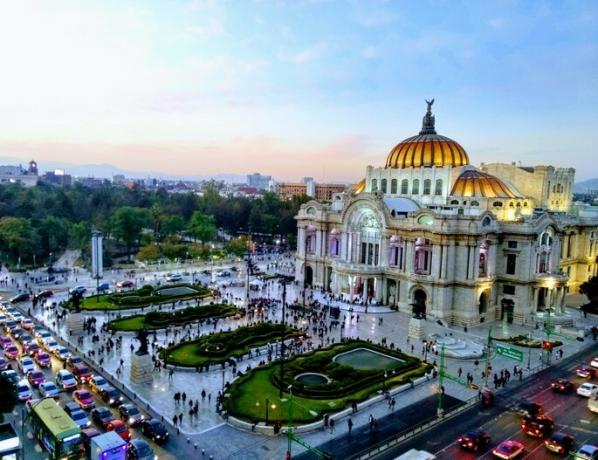
Originally entrusted to the design and care of Italian architect Adamo Boari, the building suffered interruptions before Federico E. Mariscal received the order to conclude it.
Indeed, construction was suspended in 1916, and then there were two attempts to restore it in 1919 and 1928. After this long and eventful process, it was resumed in 1931 under the care of Mariscal and, finally, the palace was inaugurated in 1934.
The political crisis, which resulted in the Mexican Revolution, was one of the determining factors, but not the only one. The interruptions would also respond to the lack of economic resources and technical aspects such as the subsidence of the land.
All this, however, did not make a dent but, on the contrary, was an opportunity to reorient and consolidate an emblematic work of contemporary Mexican culture. Let's learn more about its history and characteristics.
Characteristics
His initial inspiration was art nouveau

According to the book The Palace of Fine Arts from its conception to the present day, edited and published by the National Institute of Fine Arts and Literature of Mexico (2012), Boari was commissioned especially from the exteriors until its first suspension, except for the finishes of the system cupular.
The building was intended to be part of the ideals of universality and progress at the beginning of the century. At that time, the style in vogue corresponded to the so-called art nouveau, an artistic movement that emerged at the end of the 19th century.
The art nouveau It tried to embrace, on the one hand, the resources that the new industrial materials offered to the arts; on the other, it sought to restore the aesthetic values that the industrial revolution had subtracted, especially from architecture and everyday objects.
The curved line was the great resource of this aesthetic. With it, the hardness of industrialized materials was broken, subjecting them to the sinuosity of the forms and motifs of nature.
Contains elements of art deco

The person in charge of completing the project after its interruption was the architect Federico E. Marshal. He initiated his mission under the government of Pascual Ortiz Rubio (1930-1932). In those years after World War I, the art nouveau it had lost its novelty and validity.
A new aesthetic prevailed, undoubtedly influenced by the avant-gardes of the early twentieth century, especially Constructivism, Cubism and Futurism. In the art deco the influence of the Bauhaus also played an important role.
That was how in the Palacio de Bellas Artes de México, together with the wave and sensuality of the art nouveau, geometric elements and a greater aesthetic "rationalism" appeared.
Invokes nationalism through Mexican aesthetic elements
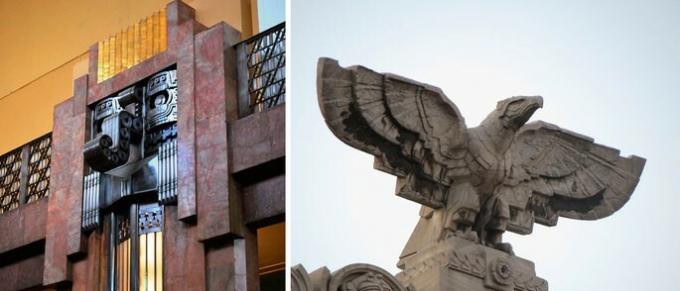
However, this should not lead us to believe that Federico E. Mariscal ignores the new political, cultural and aesthetic paths that Mexico was traveling, identified with nationalism. On the contrary, the architect is open to the culturally powerful reality of his historical time.
By the 1920s, not only has there been a nationalist artistic revolt at the hands of figures like Dr. Atl (Gerardo Murillo), but also Mexican muralism has become a reality. Like his contemporaries, Mariscal is committed to the task of reclaiming aesthetic elements of Mexican culture. Thus, the Palace of Fine Arts represents, in some way, that process of social, political, cultural and aesthetic transition in the country.
Its changes express the political and cultural turn of the nation

The cultural change was hardly expressed in the aesthetics of the palace. It was also expressed in its concept and its function.
If for Boari the building was conceived as “a great theater with large flowery spaces for the recreation of the Porfirian elites” (2012: p. 18), Mariscal thought that it should be a space for the exhibition of nationalist art.
This is how it changed its function and, of course, its name. From the National Theater, the complex was renamed the Palace of Fine Arts.
It is a multidisciplinary space

The book The Palace of Fine Arts from its conception to the present day informs us that the building contains “mural works, two museums, conference rooms, bookstores, a restaurant, a theater with its facilities, offices and parking” (2012: page 19).
This description gives an account of the universe of activities that are possible within space, but very especially it evidences the vision of those leaders who tried to take a revolutionary turn to energize the project towards the new plan of the nation Mexican.
The rigid curtain of its theater is a national symbol
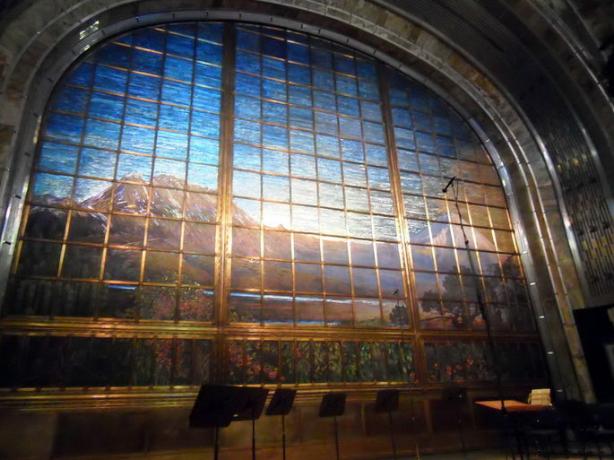
The Palace of Fine Arts houses an important theater room, since it was originally conceived as a new headquarters for the old National Theater. It was necessary to provide it with a new curtain. The fear of possible fires generated an innovative idea in Boari, his first designer.
Boari proposed a rigid double-walled steel wall clad in corrugated sheets. In them there would be a representation of the volcanoes of the Valley of Mexico: Popocatepetl and Iztaccíhuatl.
The project devised by Boari was executed by the painter and stage designer Harry Stoner, who came from the Louis C. Tiffany from New York. The work was made with almost a million pieces of opalescent glass with metallic reflections, each one measuring 2 cm.
Its decoration had the participation of international artists

Those responsible for the project, especially in the first stage, turned to internationally renowned artists for the finishes and decoration. This demonstrates the vocation of universality with which the project was born. Mexico wanted to "catch up" with the modern world, as was the case in the rest of Latin America.
Among the invited artists we can mention Leonardo Bistolfi, who made the sculptures on the main façade. Next to him, Alexandro Mazucotelli, performer of the exterior blacksmith in style art nouveau. The pegasi of the palace were under the responsibility of the artist Agustín Querol.
We must mention Géza Maróti, who was in charge of the “finishing of the dome and luminous ceiling of the performance hall and mosaic over the wall arch of the proscenium” (2012, p. 22).
See also Colon Theater in Buenos Aires.
Structural elements and applied arts

Along with the characteristics we have already described, which include intertwined stylistic and historical features, it is necessary also mention some details regarding the arts applied in the enclosure and some construction elements, mentioned in the book The Palace of Fine Arts from its conception to the present day. We will not be exhaustive, but serve this as an approach to the most representative.
- Total height of 53 meters;
- Three entrances from the main facade;
- Rectangular lobby with “Mexico” veined red marble finish on walls, columns (with tin necklaces) and pilasters, and imported granite in niches.
- Lockers: four lockers with two windows forged in bronzed and patinated copper.
- Five staircases, three central ones in black “Monterrey” marble and two lateral ones in Norwegian granite.
- Triple dome located in the center;
- The artificial lighting made with indirect diffused light in ceilings and cupola, four lamps similar to fountains; in the last level, other four monumental lamps finished off with representative sconces of the Mayan god Chac.
- Vault surrounded by a large ring of lamps with onyx diffusers from Oaxaca;
- Small windows placed at the starts of the semi-domes, and seven large windows on the north and south sides.
- Support arches of the domes in the columns and lower surfaces of the stairs.
The collection of Mexican muralism at the Palacio de Bellas Artes
In addition to being the scene of important scenic-musical events with its magnificent theater, the Palace of Fine Arts is also the custodian of some of the most important mural works of the artistic movement Mexican.
It is a collection of 17 pieces of Mexican muralism, distributed along the first and second floors. The collection is made up of the following pieces:
Murals by José Clemente Orozco
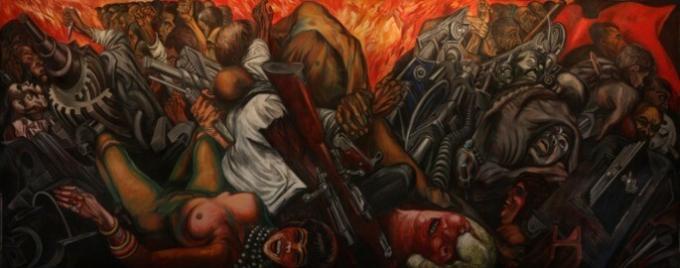
Learn more about the history, characteristics, authors and works of Mexican muralism.
Diego Rivera Murals

Learn about the history and significance of the mural in the article The controlling man of the universe by Diego Rivera.
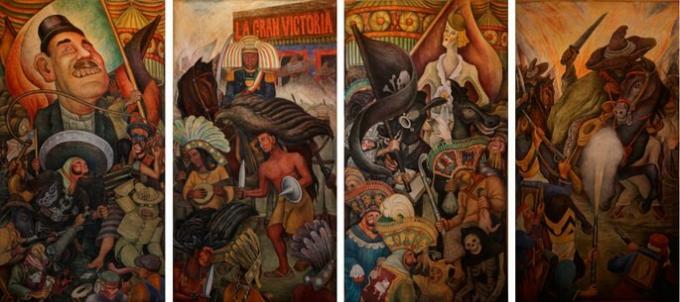
To learn more about the most important works of Diego Rivera, see the article Fundamental works of Diego Rivera.

Murals by David Alfaro Siqueiros

Discover the keys to understanding importance of Mexican muralism.

Mural by Jorge González Camarena

Roberto Montenegro Murals

Murals by Manuel Rodríguez Lozano
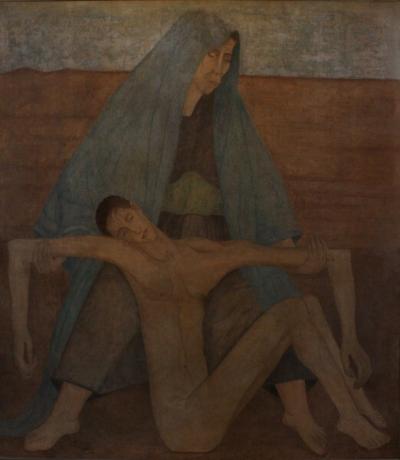
Rufino Tamayo Murals

Final thoughts
Everything exposed so far allows us to understand the patrimonial and cultural value of the Palacio de Bellas Artes in Mexico City. At the same time, the aspiration for universality, the safeguard of national identity and the commitment to a future open to progress meet in it.



